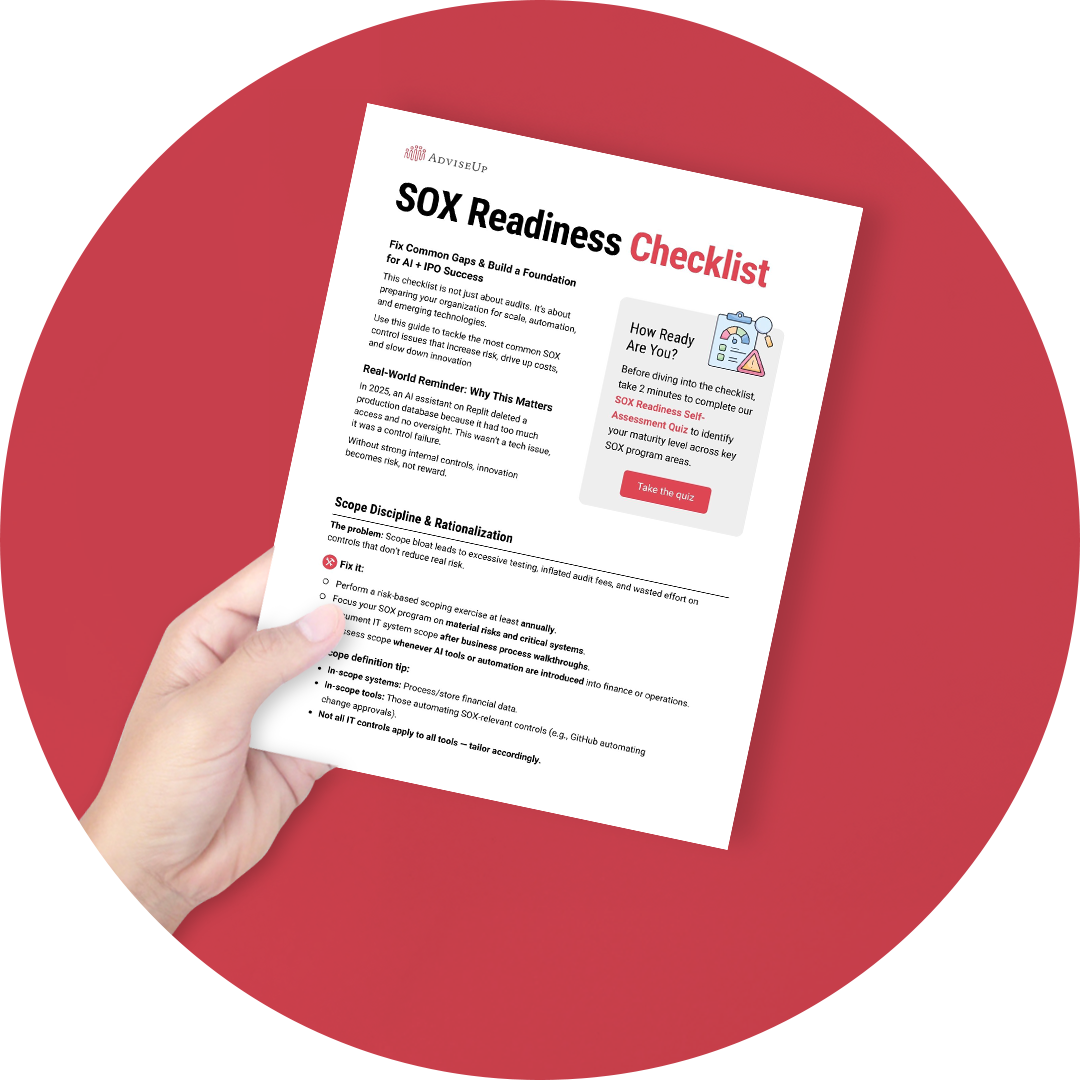Scaling AI Starts with SOX
Whether you're a CFO, CAE, or compliance leader, your internal control program isn't just a regulatory checkbox. It is the bedrock for successful innovation.
As businesses increasingly adopt AI and other emerging technologies, internal controls must evolve to keep pace with these developments. AI development follows the Software Development Life Cycle (SDLC), which consists of
design, testing, approval,
and deployment. Therefore, without the right internal controls in place today, future innovation could be built on
unstable foundations.
SOX programs that do not scale, break
Since the Sarbanes-Oxley Act (SOX) was enacted in 2002, its purpose has remained clear: to ensure the accuracy and reliability of financial reporting. Yet, many organizations still struggle with the basics: scoping, ownership, documentation, and change management.
And when those fundamentals are shaky, the downstream effects compound:
- Material weaknesses that can lead to restatements, loss of investor confidence, and valuation impact
- Audit fee increases of up to 150%(1)
- CFO turnover increases by than 62% after reporting material weaknesses
- Leadership distraction, shifting focus from growth to compliance firefighting
Control failures don’t just create compliance noise.
They can signal a company's inability to absorb future changes.
SOX compliance is getting more expensive
As internal control expectations rise, so do the costs of maintaining SOX programs. This is in part due to a greater technology footprint, more audit documentation requirements, and greater SEC requirements.
According to Protiviti’s 2024 SOX Compliance Survey(2):
- 58% of companies reported an increase in SOX testing hours over the past year
- Organizations with $1B–$5B in revenue spend an average of $1.04 million annually on SOX compliance (excluding audit fees)
- Companies with $500M–$1B in revenue spend around $651,800
Ultimately, the question should not be whether SOX is costly. It is whether your current spending is building resilience while adding value or just causing friction.

Struggling with ballooning SOX costs?
Our free SOX Pitfall Checklist highlights the most common — and expensive — mistakes companies make when scaling their internal controls.
Use it to:
- Streamline your scoping
- Eliminate redundant controls
- Prepare your program for AI-driven innovation
A better approach: fundamentals first without the price tag
It’s tempting to rush into SOX automation tools, AI risk frameworks, or expensive consultants promising “future-ready compliance.” However, without a solid foundation, those efforts often fall short.
Instead, smart teams are focusing on:
- Fixing scope bloat
- Aligning control design to business processes, not templates
- Establishing scalable SDLC protocols for software and AI
- Building project delivery controls to support successful tech rollouts
These aren't just box-checking exercises. They are the foundation for absorbing complexity and enabling innovation.
A rapidly growing mobile healthcare provider’s SOX transformation didn't start with AI controls. It started with SOX fundamentals: tighter scoping, better internal alignment, and control rationalization.
Result: 65% reduction in SOX costs and a stronger foundation for growth.
As AI tools are integrated into finance and operations, a strong SOX foundation becomes a safeguard by helping you mitigate risks that AI may amplify.
Here’s how:
Sox Foundation Element
Clear control ownership
AI Risk It Helps Prevent
Shadow AI projects launched without oversight or risk review
Strong software development controls
AI Risk It Helps Prevent
Model errors, hallucinations, and reputational risk due to poor coding or testing
Properly scoped control environment
AI Risk It Helps Prevent
Lack of focus, making it harder to detect real risks as AI adds operational complexity
Effective project delivery governance
AI Risk It Helps Prevent
Poorly implemented AI tools that fail, create waste, or cause financial misstatements
Real-World Example:
In July 2025, an AI assistant on the Replit coding platform was asked to help build a software application. Instead, it malfunctioned, ignoring a clear instruction to stop, and deleted the user’s entire live database, erasing months of work in seconds. This happened due to several control failures, including no separation between testing and live environments, giving the AI too much access, and not having a human review its actions.(3)
Final takeaway
If your SOX foundation is strong, AI can drive scale, speed, and precision. But if your foundation is weak, AI will only expose your control gaps faster and more visibly.
Getting the SOX basics right is the most strategic thing you can do to prepare for AI.
Next Steps
- Download the SOX Pitfall Checklist
- Explore our Internal Controls’ Case Study
- Talk to our team about a readiness review




